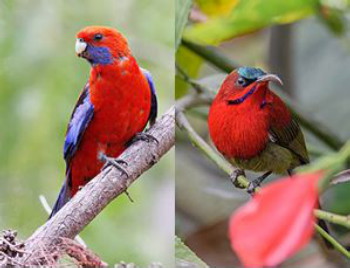COLORS ~ The Smiles of Nature ~ Part II
(A Perspective from Sri Guru Granth Sahib)
Dr. Devinder Pal Singh
Read Part I here
____________________________________
Saffron - Sacrifice and Renunciation
Saffron is also one of the predominant colors of the sunset. It is traditionally10 the color of fire, also called bhagwa, gerua or kesariya. It symbolizes the inner fire that drives a person to excel and to renounce certain worldly pleasures for the sake of greater good. In Hinduism11, the deep saffron color is associated with sacrifice, religious abstinence, quest for spiritual enlightenment and salvation. Saffron is often worn by sanyasis (ascetics). It is the battle color of the Rajputs. Buddhist monks in the Theravada tradition typically wear saffron robes. For the Sikhs, saffron symbolizes self-sacrifice and fight against injustice. Sikhs use saffron as the background color of the Nishan Sahib, the flag of the Sikh religion, upon which is displayed the khanda in blue.
Guru Nanak enunciates that all the embellishments (e.g. pearls, jewels, scented musk, saffron, and sandalwood etc.) for God's worship, though good, yet these take one's mind away from the contemplation on God. Thereby these are unnecessary.
ਮੋਤੀ ਤ ਮੰਦਰ ਊਸਰਹਿ ਰਤਨੀ ਤ ਹੋਹਿ ਜੜਾਉ ॥ ਕਸਤੂਰਿ ਕੁੰਗੂ ਅਗਰਿ ਚੰਦਨਿ ਲੀਪਿ ਆਵੈ ਚਾਉ ॥
ਮਤੁ ਦੇਖਿ ਭੂਲਾ ਵੀਸਰੈ ਤੇਰਾ ਚਿਤਿ ਨ ਆਵੈ ਨਾਉ ॥ (ਮ.1, ਪੰਨਾ 14)
If I had a palace made of pearls, inlaid with jewels, scented with musk, saffron, and sandalwood, a sheer delight to behold - seeing this, I might go astray and forget You, and Your Name would not enter into my mind. (First Mehl, SGGS, p 14)
Guru Nanak exhorts us that let the ingredients for worship be the following; our body be the saffron, our soft-speech be the jewel, our breath of life be the fragrant incense of Lord's Naam, our face be (reflect) the piousness of holy places and the mind be imbued with the love of the Lord. Such should be the offerings in the Lord's worship.
ਕੁੰਗੂ ਕੀ ਕਾਂਇਆ ਰਤਨਾ ਕੀ ਲਲਿਤਾ ਅਗਰਿ ਵਾਸੁ ਤਨਿ ਸਾਸੁ ॥
ਅਠਸਠਿ ਤੀਰਥ ਕਾ ਮੁਖਿ ਟਿਕਾ ਤਿਤੁ ਘਟਿ ਮਤਿ ਵਿਗਾਸੁ ॥
ਓਤੁ ਮਤੀ ਸਾਲਾਹਣਾ ਸਚੁ ਨਾਮੁ ਗੁਣਤਾਸੁ ॥ (ਮ. 1, ਪੰਨਾ 17)
With the body of saffron, and the tongue a jewel, and the breath of the body pure fragrant incense; with the face anointed at the sixty-eight holy places of pilgrimage, and the mind illuminated with wisdom - with that wisdom, chant the Praises of the True Name, the Treasure of Excellence. (First Mehl, SGGS, p 17)
Guru Nanak Dev describing the true way of worship of the Lord explains that let contemplation on God is the sandalwood, mind be the stone to rub it on and good deeds are the saffron for the offerings in the worship of the Lord. He emphasizes that meditation on God is real worship.
ਤੇਰਾ ਨਾਮੁ ਕਰੀ ਚਨਣਾਠੀਆ ਜੇ ਮਨੁ ਉਰਸਾ ਹੋਇ ॥ ਕਰਣੀ ਕੁੰਗੂ ਜੇ ਰਲੈ ਘਟ ਅੰਤਰਿ ਪੂਜਾ ਹੋਇ ॥੧॥
ਪੂਜਾ ਕੀਚੈ ਨਾਮੁ ਧਿਆਈਐ ਬਿਨੁ ਨਾਵੈ ਪੂਜ ਨ ਹੋਇ ॥ (ਮ. 1, ਪੰਨਾ 489)
I would make Your Name the sandalwood, and my mind the stone to rub it on; for saffron, I would offer good deeds; thus, I perform worship and adoration within my heart. ||1|| Perform worship and adoration by meditating on the Naam, the Name of the Lord; without the Name, there is no worship and adoration. (First Mehl, SGGS, p 489)
Thus in SGGS, though saffron represents sacrifice and renunciation, yet it is emphasized that observing good conduct and contemplation on God are imperative for achieving spiritual enlightenment, rather than focussing only on one's appearance and dress as a religious person.
Red - Divine Love and Joy
From the color of Grand Canyon to the algal bloom (Red Tide), from the color of sunrise or sunset to the color of autumn leaves, from the color of Mars to the color of dying stars, and from the color of Roses to color of blood, it is the prevalence of red color in Nature. In Sanskrit12, the word rudhira means red or blood. Red is one of the top two favorite colours13 of all people, second only to yellow. Since red is the color of blood, it has historically been associated with sacrifice, danger, and courage.
It is most commonly associated with fire, passionate love and joy, seduction, and sexuality. In many Asian countries, it is the color of happiness, luck, and prosperity. Red is an auspicious colour13 for marriage. Brides in India and Nepal wear red saris; in Japan, a red kimono symbolizes happiness and good luck. In Hindu religion14, red color is most frequently used for auspicious occasions like marriages, the birth of a child, festivals, etc. Red powder is usually thrown on statues of deities during prayers. It is also the color of Shakti (prowess). A red-colored dress is put on deities.
In Gurbani, red color is used as a metaphor for the spiritual passion, love, dedication, and devotion to the Lord. Gurbani exhorts us to dye our minds in the love of God in such a way that it becomes a defining feature of our life. Guru Nanak articulates that with the grace of a True Guru, the mind of a disciple gets dyed in the deep red color of the love of the Lord.
ਮਨੁ ਤਨੁ ਹੋਇ ਚੁਲੰਭੁ ਜੇ ਸਤਿਗੁਰ ਭਾਇਆ ॥ (ਮ. 1, ਪੰਨਾ 751)
The mind and body are dyed in the deep red color of devotional love if it pleases the True Guru. (First Mehl, SGGS, p 751)
Guru Arjan Dev proclaims that contemplating on God leads to getting imbued with the essence of the Lord.
ਥੀਵਹਿ ਲਾਲਾ ਅਤਿ ਗੁਲਾਲਾ ਸਬਦੁ ਚੀਨਿ ਗੁਰ ਮੀਠਾ ॥ (ਮ. 5, ਪੰਨਾ 777)
You shall take on the deep and lasting red color of the poppy, contemplating the sweet Word of the Guru's Sabd. (Fifth Mehl, SGGS, p 777)
Thus in Gurbani, red color is used as a metaphor to represent a state of divine love and joy.
Yellow - Happiness, Optimism and Spiritual Enlightenment
Yellow is the most luminous of all the colors of the spectrum15. In the natural world, yellow is the color of sunshine, sunflowers and daffodils, egg yolks and lemons, canaries and bees. In the contemporary world, yellow is the color of happiness and optimism, of enlightenment and creativity, sunshine and spring. In India, yellow is the color of spring. Fields of mustard present a colorful sight all over rural Punjab. The yellow flowers of the mustard crop cover the field in such a way that it seems as if gold is spread over the land, glittering in the rays of the sun. Using the metaphor of ‘Basant (spring)’, Guru Amar Das encourages us to see the Divine in all creation.
ਆਪਿ ਬਸੰਤੁ ਜਗਤੁ ਸਭੁ ਵਾੜੀ ॥ (ਮ. 3, ਪੰਨਾ 1177)
The Lord Himself is the season of spring; the whole world is His Garden. (Mehl Third, SGGS, p 1177)
Yellow color, because of being the color of the monks' robes16 , also symbolizes humility and detachment from materialistic society, renunciation, and desirelessness. But Guru Nanak Dev proclaims that even if an ascetic or yogi be dressed in specific colored robes, be full of the knowledge of Vedas, or have undergone extreme penance, but if he is devoid of the love of God, all these gains are worthless.
ਬਗਾ ਰਤਾ ਪੀਅਲਾ ਕਾਲਾ ਬੇਦਾ ਕਰੀ ਪੁਕਾਰ ॥
ਹੋਇ ਕੁਚੀਲੁ ਰਹਾ ਮਲੁ ਧਾਰੀ ਦੁਰਮਤਿ ਮਤਿ ਵਿਕਾਰ ॥
ਨਾ ਹਉ ਨਾ ਮੈ ਨਾ ਹਉ ਹੋਵਾ ਨਾਨਕ ਸਬਦੁ ਵੀਚਾਰਿ ॥ (ਮ. 1, ਪੰਨਾ 139)
I may dress in white, red, yellow and black dress and loudly shout out Vedas; I may even live in dirt and filth. And yet, all this is just a product of evil-mindedness, and intellectual corruption. I was not, I am not, and I will never be anything at all! O Nanak, unless I dwell on the Word of the Shabad. (First Mehl, SGGS, p 139)
Thus in Gurbani, yellow color has been used as a metaphor for happiness, optimism, spiritual enlightenment, renunciation, desirelessness, humility, and detachment. Yet it is emphasized that the love of the Lord is most valuable and it is above all kinds of symbolism.
Green - Growth, Fertility, and Calmness
Green is common in nature. Most of the plant and tree leaves are green. The green color is typically used by several animals as camouflage. Green is often used to symbolize17 rebirth or renewal, calmness and hope, tolerance and immortality. Green in the Bible is usually a reference to growth, vegetation or fertility18. Green is the sacred color of Islam19 because it was not only worn by Muhammad, but it symbolizes life and nature. In Sikhism, green color is associated with fertility, prosperity, and abundance. Using the metaphor of a tree, Guru Nanak articulates that God is like a luxuriantly green fruit-bearing tree.
ਸਫਲਿਓ ਬਿਰਖੁ ਹਰੀਆਵਲਾ ਛਾਵ ਘਣੇਰੀ ਹੋਇ ॥ (ਮ. 1, ਪੰਨਾ 59)
He is the fruit-bearing Tree, luxuriantly green with abundant shade. (First Mehl, SGGS, p 59)
Using the symbolism of green for a state of spiritual enlightenment, Guru Amar Das points out that all beings who contemplate on God, attain spiritual enlightenment and bliss.
ਸੇ ਬਿਰਖਾ ਹਰੀਆਵਲੇ ਜੋ ਗੁਰਮੁਖਿ ਰਹੇ ਸਮਾਇ ॥ (ਮ. 3, ਪੰਨਾ 1282)
Those trees become green and lush, which remain immersed in the Guru's Word. (Third Mehl, SGGS, p 1282)
Blue - Dignity, Trust, and Authority
Blue is nature’s color for water and sky, but is rarely found in fruits and vegetables. Light (sky) blue represents21 peace, serenity, ethereal, spiritual, infinity, optimism and new beginnings. Bright blue signifies cleanliness, strength, dependability, coolness. Dark blue symbolizes trust and dignity, loyalty and faith, freedom and authority. Blue has been used for art, decoration and as a clothing dye since ancient times22-23. Blue is associated24 with Christianity especially with the figure of the Virgin Mary. In Hinduism, Vishnu, Krishna and Rama are often depicted as having blue-colored skin. Shiva, the destroyer, is also depicted in light blue tones and is called Neela Kantha (blue-throated). Blue symbolism is considered serious and authoritative, without being menacing. Reporting about his contemporary times, Guru Nanak Dev reports that the people wear blue robes, to show their adherence to the authority of their Muslim rulers.
ਨੀਲ ਵਸਤ੍ਰ ਪਹਿਰਿ ਹੋਵਹਿ ਪਰਵਾਣੁ ॥ (ਮ. 1, ਪੰਨਾ 472)
Wearing blue robes, they seek the approval of the Muslim rulers. (First Mehl, SGGS, p 472)
Using the metaphor of colors, Guru Nanak articulates that let the love of God dye our mind in deep crimson, let the virtues of Truth and charity be our white dress, let eradication of wickedness be our blue clothes, and contemplation on God be our robe of honor. Let contentment be our waistband, and remembrance of God be our health and wealth. Guru Nanak proclaims that by acquiring such qualities we can prove our adherence to the authority of the Lord.
ਰਤਾ ਪੈਨਣੁ ਮਨੁ ਰਤਾ ਸੁਪੇਦੀ ਸਤੁ ਦਾਨੁ ॥ ਨੀਲੀ ਸਿਆਹੀ ਕਦਾ ਕਰਣੀ ਪਹਿਰਣੁ ਪੈਰ ਧਿਆਨੁ ॥
ਕਮਰਬੰਦੁ ਸੰਤੋਖ ਕਾ ਧਨੁ ਜੋਬਨੁ ਤੇਰਾ ਨਾਮੁ ॥ (ਮ. 1, ਪੰਨਾ 16)
Let the mind be imbued with the Lord's Love; let it be dyed a deep crimson. Let Truth and charity be white clothes. Let the erasing of the blackness of sin be the wearing of blue clothes, and meditation on the Lord's Lotus Feet be the robe of honor. let contentment be the waistband, let His Name be the wealth and youth. (First Mehl, SGGS, p 16)
White - Purity, Perfection and Righteousness
White is one of the most common colors in nature. It is the color of sunlight, clouds, flowers, snow, milk, chalk, limestone and several other minerals. In many cultures white represents25 or signifies purity, innocence, and light. In Western cultures and Japan, white is the most common color for wedding dresses, symbolizing purity and virginity. According to surveys in Europe and the United States, white is the color most often associated with perfection, the good, honesty, cleanliness, the beginning, the new, neutrality, and exactitude.
White is an important color for almost all world religions. In Christianity white symbolizes joy, and glory. In Islam and the Shinto religion of Japan, it is worn by pilgrims. In India, it is worn by the Brahmins. Saraswati, the Hindu Goddess of Knowledge, is always shown as wearing a white dress, sitting on a white lotus. As white symbolizes perfection, purity, and chastity, Bhagat Ravidas, using the metaphor of white color expresses a devotee's reverence and love for God by proclaiming that God is like a white and yellow thread of silk, whereas the devotee is like a poor silkworm, whose existence's sole cause is to bear silk.
ਤੁਮ ਮਖਤੂਲ ਸੁਪੇਦ ਸਪੀਅਲ ਹਮ ਬਪੁਰੇ ਜਸ ਕੀਰਾ ॥
ਸਤਸੰਗਤਿ ਮਿਲਿ ਰਹੀਐ ਮਾਧਉ ਜੈਸੇ ਮਧੁਪ ਮਖੀਰਾ॥ (ਭਗਤ ਰਵਿਦਾਸ, ਪੰਨਾ 486)
You are the white and yellow threads of silk, and I am like a poor worm. O Lord, I seek to live in the Company of the Saints, like the bee with its honey. (Bhagat Ravidas, SGGS, p 486)
White can sometimes have a negative meaning26-27 as well. In China, it symbolizes age, autumn, misfortune, and mourning. In India, it is the acceptable color at funerals and ceremonies that mark death in the family. A Hindu widow wears a white dress in mourning. Using the metaphor of white color for death/destruction, Guru Nanak articulates that a person who is bestowed upon the gifts of spiritual wisdom and contemplation by God, all the demons of maya loss their spell (turn white) on him. Such a person enjoy the eternal bliss of God's love.
ਗਿਆਨੁ ਧਿਆਨੁ ਸਭ ਦਾਤਿ ਕਥੀਅਲੇ ਸੇਤ ਬਰਨ ਸਭਿ ਦੂਤਾ ॥
ਬ੍ਰਹਮ ਕਮਲ ਮਧੁ ਤਾਸੁ ਰਸਾਦੰ ਜਾਗਤ ਨਾਹੀ ਸੂਤਾ ॥ (ਮ. 1, ਪੰਨਾ 503)
Spiritual wisdom and meditation are all said to be God's gifts; all of the demons are turned white before him. He enjoys the taste of the honey of God's lotus; he remains awake and does not fall asleep. (First Mehl, SGGS, p 503)
Guru Nanak Dev makes us aware that although the white color is symbolic of purity, perfection, and righteousness, yet the persons dressed in white may not be necessarily possessing these qualities.
ਬਗਾ ਬਗੇ ਕਪੜੇ ਤੀਰਥ ਮੰਝਿ ਵਸੰਨ੍ਹ੍ਹਿ॥
ਘੁਟਿ ਘੁਟਿ ਜੀਆ ਖਾਵਣੇ ਬਗੇ ਨਾ ਕਹੀਅਨ੍ਹ੍ਹਿ॥ (ਮ. 1, ਪੰਨਾ 729)
The herons in their white feathers dwell in the sacred shrines of pilgrimage. They tear apart and eat living beings, and so they are not called white. (First Mehl, SGGS, p 729)
Crimson - Divinity
Crimson is a strong, bright, deep red color combined with some blue and/or violet, resulting in a tiny degree of purple. The crimson tide, which sometimes occurs on beaches, is caused by a type of algae. Crimson rosellas are a subspecies of parrot that are common in Australia. Crimson is produced using the dried bodies of the kermes28 insect. Crimson carries the symbolism29 of red as a power color and the color of love. In the Elizabethan era, crimson was associated with royalty, nobility, and others of high social standing. Guru Nanak Dev expresses the divine nature of crimson color, by articulating that it is imbued with the essence of God.
ਆਪੇ ਹੀਰਾ ਨਿਰਮਲਾ ਆਪੇ ਰੰਗੁ ਮਜੀਠ ॥ (ਮ. 1, ਪੰਨਾ 54)
You are the flawless diamond; You are the deep crimson color. (First Mehl, SGGS, p 54)
Guru Arjan Dev describes that a person, who is has imbibed the love of God in his life, is imbued with the divine color of deep crimson.
ਮੁਹਬਤਿ ਜਿਸੁ ਖੁਦਾਇ ਦੀ ਰਤਾ ਰੰਗਿ ਚਲੂਲਿ ॥ (ਮ. 5, ਪੰਨਾ 966)
One who loves God is imbued with the deep crimson color of His love. (Fifth Mehl, SGGS, p 966)
(to be continued...)













